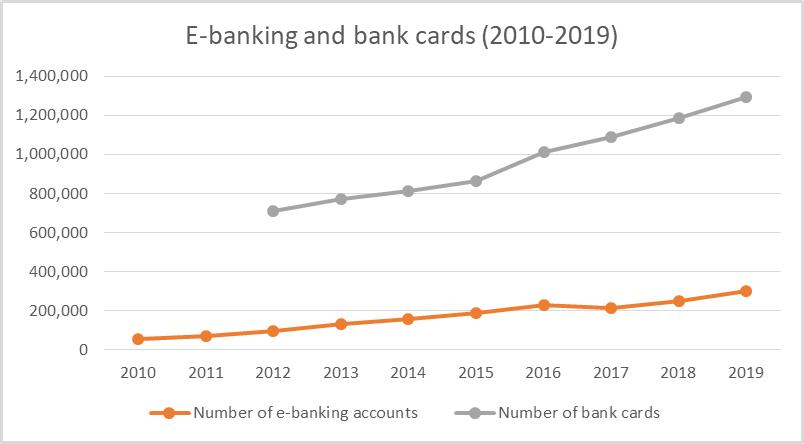
4 minute read
Dr. Petrit BALIJA
Banking Services Sector: A frontrunner in Kosovo BANKING SYSTEM
Financial inclusion remains a continuous priority for the banking services sector in Kosovo, which can be achieved through financial literacy, product design, improvements in payments infrastructure and digitalization of services.
Advertisement
Dr. Petrit BALIJA CEO KOSOVO BANKING ASSOCIATION (KBA)
The banking services sector comprises the largest part of the Kosovo financial system. There are 10 commercial banks operating in Kosovo, representing over EUR 4.5 billion in assets, which have been growing steadily over the last two decades, since the building foundations of the financial system of Kosovo were set out in 1999. The banking services sector is a driving force and a frontrunner in the economic development of Kosovo.
Deposits and lending Banks have created a high trust environment within the social and economic ecosystem in Kosovo. This high trust has allowed for a higher level of productivity and a gradual, but consistent growth of the banking sector. In 2019, this trust was confirmed once again with a high growth rate in deposits, respectively a 16% annual growth. Total deposits reached over EUR 3.9 billion while the loans portfolio grew by 10% to EUR 3 billion.
Enterprise lending Access to finance for businesses is vital to the economy, because it allows for expansion and increase of capacities, human and otherwise, creating the right momentum for a business to thrive. Banks in Kosovo have played a pivotal role in the development of business corporations and SMEs in the country. This collaboration between enterprises and banks has not been developed without its challenges, considering that both financial system and private sector were established at the same time, some two decades ago. At the beginning, there

was a lack of credit history, lack of business assets, scarce qualified human resources and a deficient legislative framework. Nevertheless, banks found ways to support enterprises in Kosovo and provided the much-needed access to finance and a very reliable payments infrastructure, while investing in human resources and building impressive professional capacities.
Loans to enterprises represents the largest portion of the total loan portfolio, at around 65%. There is a wide distribution of sectors of the economy that comprise the loan portfolio. Trade sector occupies the largest portion at 44% of total loans and leases, while the lowest extension of loans is to sectors in energy, mining and agriculture. However, the trend is towards a more balanced portfolio between different sectors. This is evident, because lending to trade has decreased from 52% in 2016
to 44% in 2019. Sectors that have gained in this adjustment are manufacturing, construction and, to a lesser extent, the hospitality industry. For the first time, the portion of loans to manufacturing has increased to above 13.7% of total loans.
There have been great improvements, in terms of interest rate affordability of businesses, as loan interest rates have been on a downward trend, during the past five years. While in 2013, the average loan interest rate was above 10%, now this interest rate is at 6.4% and even less for enterprises, at an average of 6.2%. This downward trend has greatly contributed to the significant growth in the loan portfolio, during this period. Trends The key indicators of the banking sector show that commercial banks in Kosovo are well above the minimum regulatory capital adequacy ratio; there is an impressive return on equity and return on assets, while the non-performing loans are at a historic low. Therefore, this is a great time to invest in further development of banks. In line with this, the banking services sector in Kosovo is keen on participating in digital developments, that are impacting the financial services. They have invested in providing a range of digital platforms for their customers and have succeeded in growing the level of electronic transactions, year after year.
There is a significant growth in online banking accounts and online transactions, as well as bank card transactions. Banks have been able to provide user-friendly payment solutions, such as: mobile banking and digital wallet applications. Nevertheless, the dynamic of technological advancements and digitization of services poses a challenge for banks, because it requires significant investments from banks, in the process of digitalization, as well as operational changes and cybersecurity enhancements.


Challenges and opportunities Over the years, the banking sector has performed well; nevertheless, many challenges and opportunities lie ahead. Kosovo has not experienced its full potential yet, due to many different constraints, political, social, economic and environmental. This unexplored potential will come into fruition in the upcoming years, which will require a robust banking services sector that can fulfill the needs of the faster growth that Kosovo expects to undergo. The banking sector will need to have a well consolidated legal framework, harmonized closely with European directives and best banking practices. Accordingly, banks will have to be ready to adapt to the new financial reporting, AML and regulatory compliance standards.
Furthermore, financial inclusion remains a continuous priority for the banking services sector in Kosovo, which can be achieved through financial literacy, product design, improvements in payments infrastructure and digitalization of services. The banking services sector will continue to remain the frontrunner in the effort to achieve greater financial and social wellbeing for Kosovo’s citizens and enterprises.





